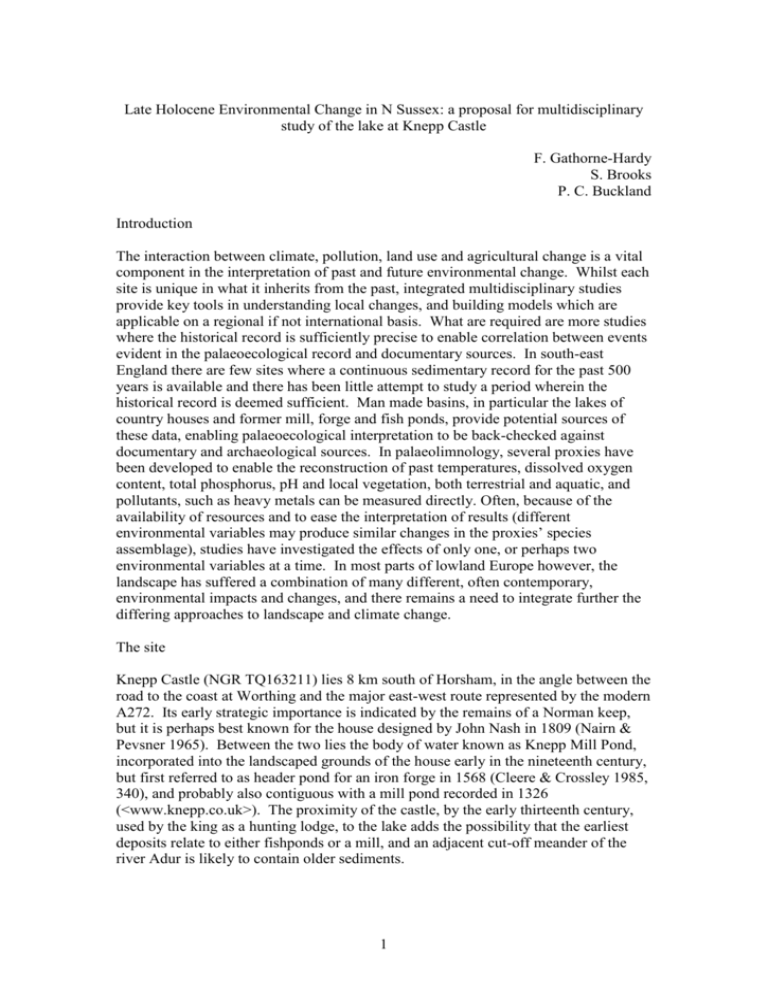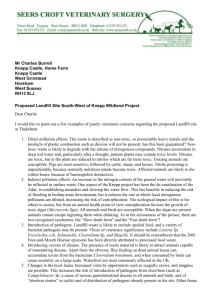Knepp Mill Pond sediment Study Proposal
advertisement

Late Holocene Environmental Change in N Sussex: a proposal for multidisciplinary study of the lake at Knepp Castle F. Gathorne-Hardy S. Brooks P. C. Buckland Introduction The interaction between climate, pollution, land use and agricultural change is a vital component in the interpretation of past and future environmental change. Whilst each site is unique in what it inherits from the past, integrated multidisciplinary studies provide key tools in understanding local changes, and building models which are applicable on a regional if not international basis. What are required are more studies where the historical record is sufficiently precise to enable correlation between events evident in the palaeoecological record and documentary sources. In south-east England there are few sites where a continuous sedimentary record for the past 500 years is available and there has been little attempt to study a period wherein the historical record is deemed sufficient. Man made basins, in particular the lakes of country houses and former mill, forge and fish ponds, provide potential sources of these data, enabling palaeoecological interpretation to be back-checked against documentary and archaeological sources. In palaeolimnology, several proxies have been developed to enable the reconstruction of past temperatures, dissolved oxygen content, total phosphorus, pH and local vegetation, both terrestrial and aquatic, and pollutants, such as heavy metals can be measured directly. Often, because of the availability of resources and to ease the interpretation of results (different environmental variables may produce similar changes in the proxies’ species assemblage), studies have investigated the effects of only one, or perhaps two environmental variables at a time. In most parts of lowland Europe however, the landscape has suffered a combination of many different, often contemporary, environmental impacts and changes, and there remains a need to integrate further the differing approaches to landscape and climate change. The site Knepp Castle (NGR TQ163211) lies 8 km south of Horsham, in the angle between the road to the coast at Worthing and the major east-west route represented by the modern A272. Its early strategic importance is indicated by the remains of a Norman keep, but it is perhaps best known for the house designed by John Nash in 1809 (Nairn & Pevsner 1965). Between the two lies the body of water known as Knepp Mill Pond, incorporated into the landscaped grounds of the house early in the nineteenth century, but first referred to as header pond for an iron forge in 1568 (Cleere & Crossley 1985, 340), and probably also contiguous with a mill pond recorded in 1326 (<www.knepp.co.uk>). The proximity of the castle, by the early thirteenth century, used by the king as a hunting lodge, to the lake adds the possibility that the earliest deposits relate to either fishponds or a mill, and an adjacent cut-off meander of the river Adur is likely to contain older sediments. 1 Despite losses to a fire early in the last century, documentation for the Knepp Estate remains remarkably complete and include both estate maps and contemporary paintings. Once the largest lake in south-east England, Knepp Mill Pond now has an area of only eleven hectares, and a maximum surviving depth of less than a metre. In an attempt to return the lake to something like its former extent and depth, it is proposed that it be dredged. There is therefore an urgent need to carry out any palaeolimnological research before this takes place. Preliminary cores close to the dam, using both a tapper corer and a gravity surface sampler, have recovered approximately120 cm of sediment. Hypotheses to be tested: 1: The little Ice Age and 20th century warming will have affected the lake biota. 2: 20th century farming had a greater impact on the lake’s biota than did 17th and 18th century farming. 3: Neither the 16th century iron workings, nor the 20th century road building and use have affected the lake. 4: The current re-wilding programme is already affecting the ecology of the lake. Methods We propose to carry out a multi-proxy examination of the lake core. We will investigate the subfossil chironomids (NHM and Bournemouth), diatoms (UCL), pollen (Aberdeen) and sediments (Bournemouth). Samples will be identified, and the results analysed, using appropriate statistical methods. The environmental variables most affecting the biota will be identified, allowing us to understand this lake through history. Variables Temperature will be reconstructed using a chironomid based transfer function, which has been shown to be effective, even over small (<1°C) changes (Brooks 2006). However, other environmental variables (particularly productivity) can affect climate reconstructions, so we will compare the chironomid-inferred temperature (CIT) with the nearby Central England Temperature dataset (CET, 1649-present) and identify any points where the CIT deviates from this. Knowing the point of deviation, we will be able to (looking closely at both the other proxies and the chironomids) quantify its cause. Total Phosphorus (the limiting nutrient in most lakes) will be reconstructed using the diatom composition, which has been shown to be a reliable proxy in most situations (REF). Dissolved oxygen content (DOC) Where temperature is not the environmental variable explaining chironomid composition (as is likely for much of the core in such a modified environment), we will apply a DOC transfer function (Quinlan and Smol 2001) giving another measure of the lake’s productivity. 2 Vegetation will be investigated palynologically, enhancing our knowledge of the catchment’s changing landscape, as well as providing insight into floral changes in the lake itself. Chemical/ metal pollution (from 16th Century iron works and more recent lead input from vehicles on the nearby A24 and A272) will be measured both directly from the sediments, and through examining the chironomid assemblages and deformities in their head capsules (Ilyashuk et al. 2003), as well as changes in the other proxies. Sediment will be examined. C:N ratios, LOI and magnetic susceptibility will all be measured, as well as possible pollutants and other trace elements in appropriate sections of the core. Dating. We will use both 210Pb and 14C dating to build a temporal framework. Outcomes This project will enable us to reconstruct the ecological impacts of environmental changes to the environs of Knepp millpond for the past ~500 years. Among other things, it will enable us to assess the ecological impact of an early modern industrial site, to compare the impacts of early modern and 20th century arable farming, and to evaluate resilience, resistance to and recovery from disturbance in the different proxies. The knowledge gained about the previous landscapes will act as a baseline for understanding what can be achieved in the current Knepp/ EN re-wilding project. The multiple lines of evidence will also enable us to make progress on disentangling some of the palaeolimnological signals (e.g. increases in lake productivity affecting CIT), and identifying tipping points where the signal from another environmental variable overrides that being measured. This will be of extremely useful baseline information in interpreting palaeolimnological signals in other studies. Most importantly, as this core will encompass several periods of climate warming, these can be categorised, and this study then used to predict some impacts of future climate change on the lowland English landscape. We plan to publish our results in suitably high-impact journals and present them at international conferences, as well as being given to English Nature and Sussex Wildlife Trust. We also plan to incorporate the results into the popular Knepp website, and present them as part of the Natural History Museum’s Nature Live programme (regular public symposia, also webcast). References Sutherland WJ, Armstrong-Brown S, Armsworth PR, Brereton T, Brickland J, Campbell CD, Chamberlain DE, Cooke AI, Dulvy NK, Dusic NR, Fitton M, Freckleton RP, Godfray HCJ, Grout N, Harvey HJ, Hedley C, Hopkins JJ, Kift NB, Kirby J, Kunin WE, Macdonald DW, Marker B, Naura M, Neale AR, Oliver T, Osborn D, Pullin AS, Shardlow MEA, Showler DA, Smith PL, Smithers RJ, Solandt JL, Spencer J, Spray CJ, Thomas CD, Thompson J, Webb SE, Yalden DW, Watkinson AR 2006. The identification of 100 ecological questions of high policy relevance in the UK. Journal of Applied Ecology 43: 617-627 3









